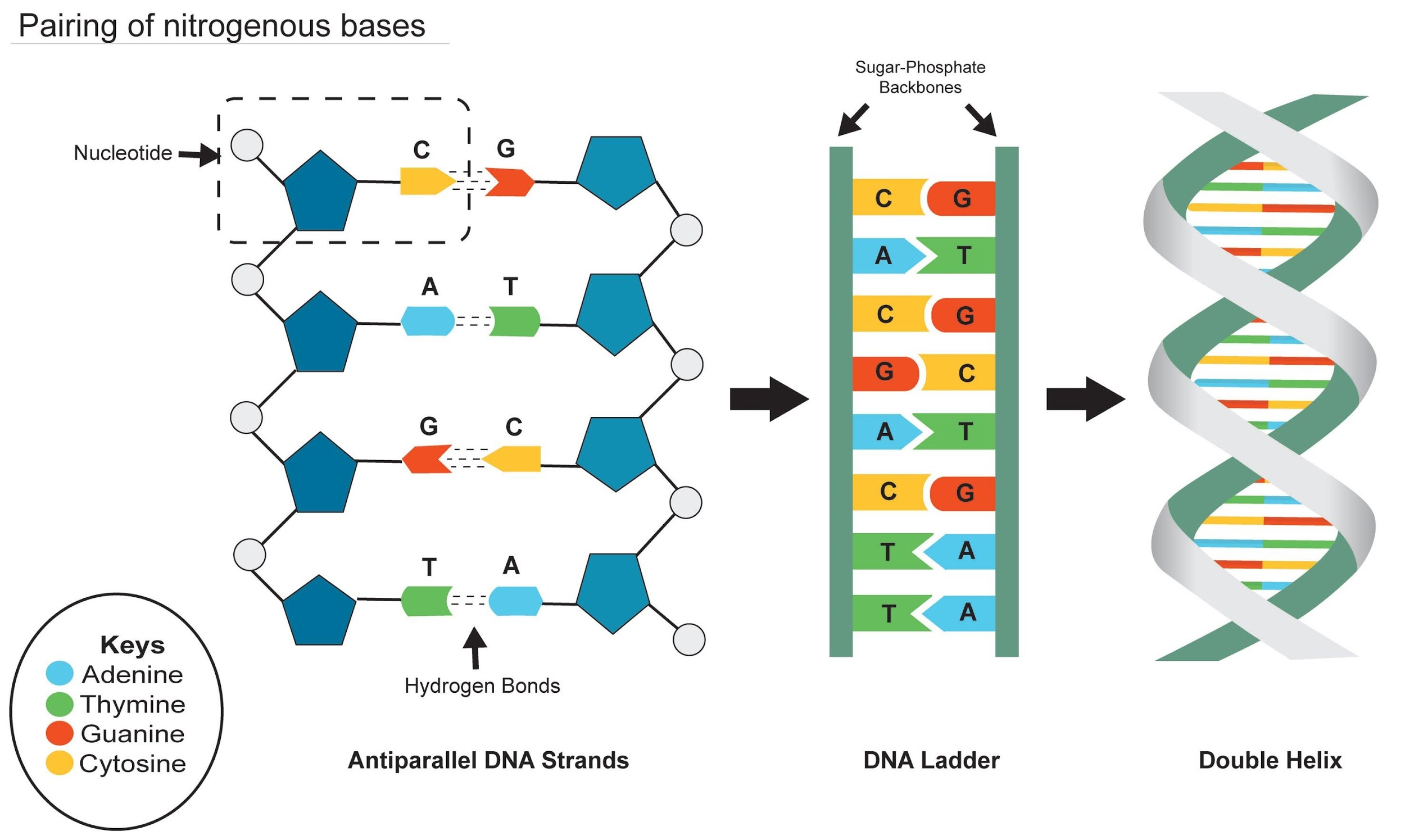
Adenine of DNA is equimolar with
(a) Uridine
(b) Thymine
(c) Guanine
(d) Cytosine
Answer
523.7k+ views
Hint: The DNA present in any cell of any organism should have a 1:1 stoichiometric ratio (base pair rule) of pyrimidine and purine bases and, more specifically, the amount of guanine should be equal to cytosine and the amount of adenine should be equal to thymine, known as The Chargaff's rules. According to the rule, this pattern is applicable in both strands of the DNA. This rule is discovered by a scientist named Austrian-born chemist Erwin Chargaff in the late 1940s.
Complete answer:
The nitrogenous bases are purines and pyrimidines. The purines are adenine and guanine. The pyrimidines are thymine and cytosine. The purines are double-ring structures while the pyrimidines are the single ring made up of carbon and nitrogen. Purines pair with the pyrimidines by hydrogen bonds. Adenine pairs with thymine by two hydrogen bonds while the cytosine pairs with the guanosine by three hydrogen bonds. According to Chargaff’s rule, the total number of adenine is equal to the total number of thymine and a 1:1 ratio exists between pyrimidine and purine bases.

Additional information:
1) First parity rule by Chargaff is that a double-stranded DNA molecule, globally has percentage base-pair equality: $\%A = \%T$ and $\%G = \%C$. The basis of the Watson-Crick pairs in the DNA double helix model constitutes by the validation of this rule.
2) Chargaff gave the second parity rule as that both $\%A = \%T$ and $\%G = \%C$ is valid for each of the two DNA strands which describe that a single DNA strand has a global feature of the base composition.
3) In bacterial genomes, the combined effect of Chargaff's second rule and Szybalski's rule can be seen where the coding sequences are not equally distributed. The genetic code has 64 codons of which 3 functions as termination codons: there are only 20 amino acids normally present in proteins.
4) There are two uncommon amino acids found in a limited number of proteins and encoded by the stop codons. They are selenocysteine (TGA) and pyrrolysine (TAG) .
So, the correct answer is, ‘Thymine’.
Note: The covalent bond joined the nucleotides together between the phosphate group of one nucleotide and the third carbon atom of the pentose sugar in the next nucleotide which produces the polynucleotide chain all along with an alternating backbone of sugar-phosphate - sugar-phosphate.
Complete answer:
The nitrogenous bases are purines and pyrimidines. The purines are adenine and guanine. The pyrimidines are thymine and cytosine. The purines are double-ring structures while the pyrimidines are the single ring made up of carbon and nitrogen. Purines pair with the pyrimidines by hydrogen bonds. Adenine pairs with thymine by two hydrogen bonds while the cytosine pairs with the guanosine by three hydrogen bonds. According to Chargaff’s rule, the total number of adenine is equal to the total number of thymine and a 1:1 ratio exists between pyrimidine and purine bases.

Additional information:
1) First parity rule by Chargaff is that a double-stranded DNA molecule, globally has percentage base-pair equality: $\%A = \%T$ and $\%G = \%C$. The basis of the Watson-Crick pairs in the DNA double helix model constitutes by the validation of this rule.
2) Chargaff gave the second parity rule as that both $\%A = \%T$ and $\%G = \%C$ is valid for each of the two DNA strands which describe that a single DNA strand has a global feature of the base composition.
3) In bacterial genomes, the combined effect of Chargaff's second rule and Szybalski's rule can be seen where the coding sequences are not equally distributed. The genetic code has 64 codons of which 3 functions as termination codons: there are only 20 amino acids normally present in proteins.
4) There are two uncommon amino acids found in a limited number of proteins and encoded by the stop codons. They are selenocysteine (TGA) and pyrrolysine (TAG) .
So, the correct answer is, ‘Thymine’.
Note: The covalent bond joined the nucleotides together between the phosphate group of one nucleotide and the third carbon atom of the pentose sugar in the next nucleotide which produces the polynucleotide chain all along with an alternating backbone of sugar-phosphate - sugar-phosphate.
Recently Updated Pages
The number of solutions in x in 02pi for which sqrt class 12 maths CBSE

Write any two methods of preparation of phenol Give class 12 chemistry CBSE

Differentiate between action potential and resting class 12 biology CBSE

Two plane mirrors arranged at right angles to each class 12 physics CBSE

Which of the following molecules is are chiral A I class 12 chemistry CBSE

Name different types of neurons and give one function class 12 biology CBSE

Trending doubts
One Metric ton is equal to kg A 10000 B 1000 C 100 class 11 physics CBSE

What is 1s 2s 2p 3s 3p class 11 chemistry CBSE

Discuss the various forms of bacteria class 11 biology CBSE

State the laws of reflection of light

Explain zero factorial class 11 maths CBSE

An example of chemosynthetic bacteria is A E coli B class 11 biology CBSE




